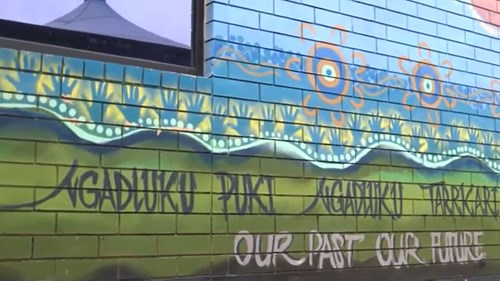St Joseph’s Catholic Primary School
Framework for Aboriginal Languages and Torres Strait Islander Languages
- Aboriginal and Torres Strait Islander Histories and Cultures
The Framework for Aboriginal Languages and Torres Strait Islander Languages provides a direct way of learning about and engaging with diverse Aboriginal and Torres Strait Islander communities. Aboriginal and Torres Strait Islander Histories and Cultures are an integral part of learning Aboriginal languages and Torres Strait Islander languages as there is an inseparable connection between the languages and land, sea, sky and waterways. Through learning a framework language, all students gain access to knowledge and understanding of Australia that can only come from an Aboriginal or Torres Strait Islander perspective.
For Aboriginal and Torres Strait Islander students, learning their own language can have a significant influence on their overall learning and achievements. It can foster a strong sense of identity, pride and self-esteem and enables students to develop a wider recognition and understanding of their culture, Country/Place and People. This then contributes to their wellbeing.
|
Code |
Organising ideas |
|
Country/Place |
|
|
OI.1 |
Australia has two distinct Indigenous groups: Aboriginal Peoples and Torres Strait Islander Peoples, and within those groups there is significant diversity. |
|
OI.2 |
Aboriginal and Torres Strait Islander communities maintain a special connection to and responsibility for Country/Place. |
|
OI.3 |
Aboriginal and Torres Strait Islander Peoples have holistic belief systems and are spiritually and intellectually connected to the land, sea, sky and waterways. |
|
Culture |
|
|
OI.4 |
Aboriginal and Torres Strait Islander societies have many Language Groups. |
|
OI.5 |
Aboriginal and Torres Strait Islander Peoples’ ways of life are uniquely expressed through ways of being, knowing, thinking and doing. |
|
OI.6 |
Aboriginal and Torres Strait Islander Peoples live in Australia as first peoples of Country or Place and demonstrate resilience in responding to historic and contemporary impacts of colonisation. |
|
People |
|
|
OI.7 |
The broader Aboriginal and Torres Strait Islander societies encompass a diversity of nations across Australia. |
|
OI.8 |
Aboriginal and Torres Strait Islander Peoples' family and kinship structures are strong and sophisticated. |
|
OI.9 |
The significant contributions of Aboriginal Peoples and Torres Strait Islander Peoples in the present and past are acknowledged locally, nationally and globally. |
Teaching resources
AIATSIS - Australian Institute of Aboriginal and Torres Strait Islander Studies: https://aiatsis.gov.au/
Australian Curriculum Framework for Aboriginal Languages and Torres Strait Islander Languages: https://www.australiancurriculum.edu.au/f-10-curriculum/languages/framework-for-aboriginal-languages-and-torres-strait-islander-languages/
The Miriwoong Language Nest: http://mirima.org.au/mdwg-work/language-nest/
Miriwoong Mobile App: http://mirima.org.au/mdwg-work/miriwoong-app/
Mirima Dawang Woorlab-gerring Language and Culture Centre (MDWg): http://mirima.org.au/
Saint Joseph's Catholic Primary School Kununurra: https://www.stjoknx.wa.edu.au/
Department of Education Western Australia: https://www.education.wa.edu.au/
Reflecting on this Illustration of Practice:
- What are the reasons for St Joseph’s implementing Miriwoong as the language curriculum through the Language Nest?
- How does the school engage with the Language Nest?
- How is the community working with Miriwoong people to revive and teach the language?
- What are the benefits of the Miriwoong language program for the students (Aboriginal and non-Aboriginal), in this school and community?
- How is the Language Nest using and adapting the AC: Aboriginal Languages and Torres Strait Islander Languages Framework in their planning and implementation?
- How does the school deliver an authentic Miriwoong language and cultural experience?
- How does the school cater for all learners?
- How do St Joseph’s classroom teachers support the teaching and learning of Miriwoong?
In your school context:
- How could you implement an Aboriginal Languages or Torres Strait Islander Languages program? Do you have the option to engage with a Language Centre or external provider?
- Which Curriculum pathway (LR, L1, L2) would be the most appropriate for your school and community context and why?
- What requirements would your school and the community need to discuss? How would the consultation and engagement processes establish the foundation for the language program?
- Identify how an Aboriginal Language or Torres Strait Islander Language program would benefit your students, school and community.
- Identify a process to review the initial program goals and measure growth and success.
Acknowledgements and disclaimers
ACARA acknowledges that the filming for this Illustration of Practice took place on the traditional land, sky and waterways of the Miriwoong People.
Aboriginal and Torres Strait Islander viewers are warned that the videos in this Illustration of Practice may contain images and voices of deceased persons.
ACARA would like to thank:
- The Miriwoong Community and Elders
- Miriwoong teachers and leaders
- Mirima Dawang Woorlab-gerring Language and Culture Centre (MDWg)
- The Miriwoong Language Nest
- St Joseph’s Catholic Primary School Kununurra
- Aboriginal Languages Curriculum Support, Department of Education WA
- The Commonwealth Government for funding this Illustration of Practice through the Endeavour Language Teachers Fellowship

